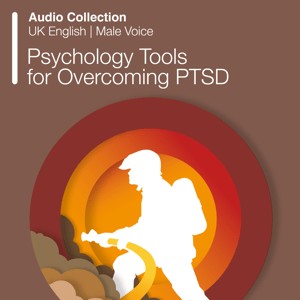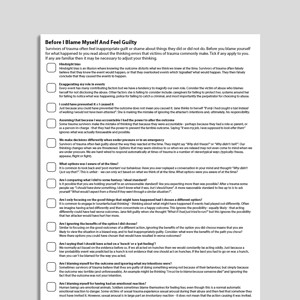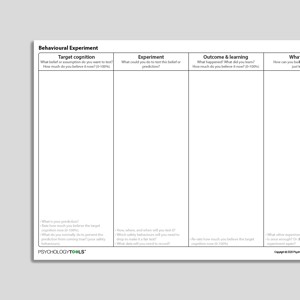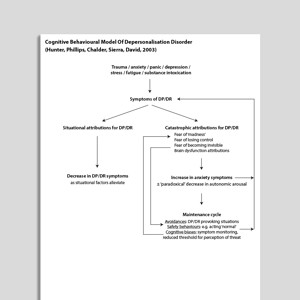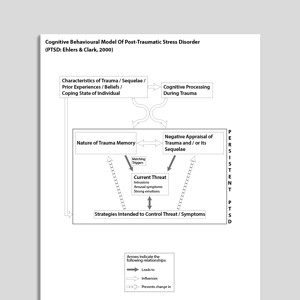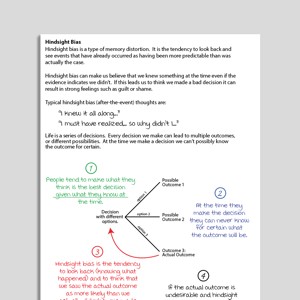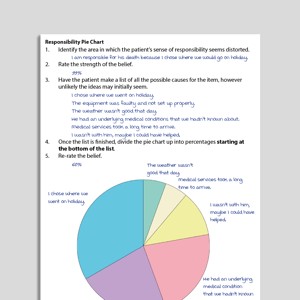Post-Traumatic Stress Disorder (PTSD) and Complex Post-Traumatic Stress Disorder (CPTSD)
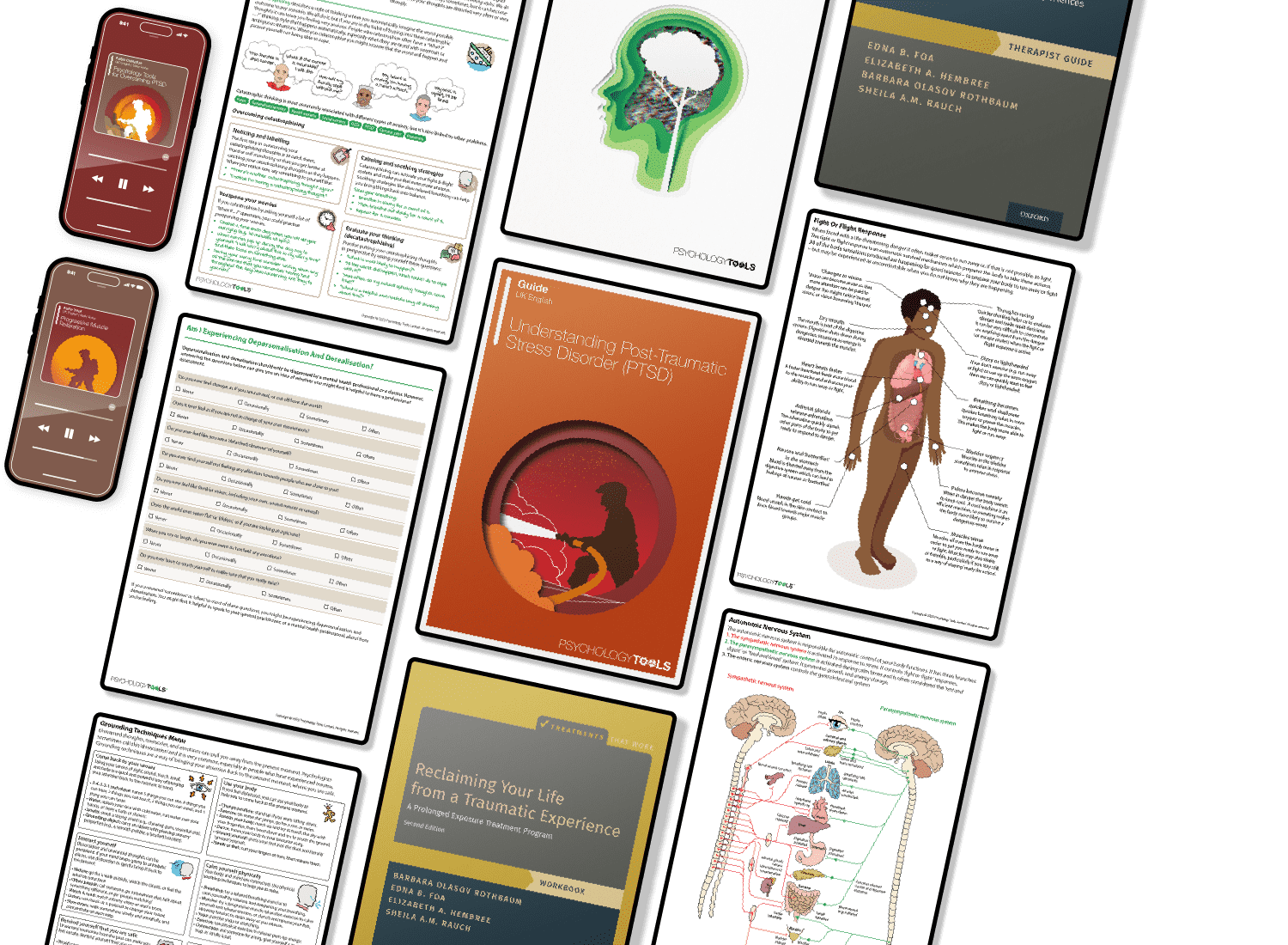
Am I Experiencing Depersonalization And Derealization?
Am I Experiencing Post-Traumatic Stress Disorder (PTSD)?
Arbitrary Inference
Audio Collection: Psychology Tools For Overcoming PTSD
Autonomic Nervous System
Barriers Abusers Overcome In Order To Abuse
Before I Blame Myself And Feel Guilty
Behavioral Experiment
Behavioral Experiment (Portrait Format)
Catastrophizing
Coercive Methods For Enforcing Compliance
Cognitive Behavioral Model Of Depersonalization (Hunter, Phillips, Chalder, Sierra, David, 2003)
Cognitive Behavioral Model Of Post Traumatic Stress Disorder (PTSD: Ehlers & Clark, 2000)
Critical Care And PTSD
Critical Illness Intensive Care And Post-Traumatic Stress Disorder (PTSD)
Disqualifying Others
Dissociation - Self-Monitoring Record
EMDR Negative And Positive Cognitions
EMDR Protocol (Standard)
EMDR Protocol (With Interweave Guidance)
Emotional Deprivation
Emotional Reasoning
Externalizing
Fight Or Flight Response
Flashbacks - Self-Monitoring Record
Fortune Telling
Grounding Objects (Audio)
Grounding Statements (Audio)
Grounding Techniques
Grounding Techniques Menu
Habituation
Hindsight Bias
Hindsight Bias (Archived)
Hotspot Record
How Trauma Can Affect You (CYP)
Intrusive Memory Record
Maximizing The Effectiveness Of Exposure Therapy
Nightmare Exposure And Rescripting
Nightmare Rescripting (Audio)
Personalizing
Pie Charts (Archived)
Progressive Muscle Relaxation (Audio)
Prolonged Exposure Therapy For PTSD (Second Edition): Therapist Guide
Properties Of Trauma Memories
PTSD And Memory
PTSD Film Projection Metaphor
PTSD Linen Cupboard Metaphor
Reactions To Trauma
Reclaiming Your Life From A Traumatic Experience (Second Edition): Workbook
Recognizing Complex Post Traumatic Stress Disorder
Responses To Threat: Freeze, Appease, Flight, Fight
Responsibility Pie Chart
Rewind Technique
Self-Blame
Sensory Grounding Using Smells (Audio)
Sensory Grounding Using Your Five Senses (Audio)
Social Comparison
Stimulus Discrimination (Audio)
Therapy Blueprint (Universal)
Therapy Blueprint For PTSD
Trauma And Dissociation
Trauma, Dissociation, And Grounding (Archived)
Understanding Depersonalization And Derealization
Understanding Post-Traumatic Stress Disorder (PTSD)
Links to external resources
Psychology Tools makes every effort to check external links and review their content. However, we are not responsible for the quality or content of external links and cannot guarantee that these links will work all of the time.
Assessment
-
Brief Dissociative Experiences Scale (DES-B)
| Dalenberg, Carlson | 2010
- Scale
- DES-B (Dalenberg C, Carlson E, 2010) modified for DSM-5 by C. Dalenberg and E. Carlson.
Resources related to the assessment of post-traumatic stress disorder (PTSD)
- Wilson, J.P., & Keane, T.M. (Eds.). (2004). Assessing psychological trauma and PTSD: A practitioner’s handbook (2nd ed.). New York, NY: Guilford Press.
-
Shutdown Dissociation Scale (Shut-D)
| Schauer, Schalinski, Elbert | 2015
- Scale (English)
- Scale (German)
- Scale (Norwegian)
- Reference Schalinski, I., Schauer, M., & Elbert, T. (2015). The Shutdown Dissociation Scale (Shut-D). European Journal of Psychotraumatology, 6
-
Dissociative Experiences Scale – II (DES-II)
| Carlson, Putnam | 1993
- Scale
- Carlson, E.B. & Putnam, F.W. (1993). An update on the Dissociative Experience Scale. Dissociation 6(1), p. 16-27.
Screening, diagnostic, and outcome-measurement tools for post-traumatic stress disorder (PTSD)
-
Trauma Screening Questionnaire (TSQ)
| Brewin, Rose, Andrews, Green, Tata, McEvedy, Turner, Foa | 2002
- Brewin, C. R, Rose, S., Andrews, B., Green, J., Tata, P., McEvedy, C. Turner, S, Foa, E. B. (2002). Brief screening instrument for post-traumatic stress disorder. British Journal of Psychiatry, 181, 158-162.
- Scale
-
Trauma Appraisal Questionnaire (TAQ)
| DePrince, Zurbruggen, Chu, Smart | 2010
- DePrince, A. P., Zurbriggen, E. L., Chu, A. T., & Smart, L. (2010). Development of the trauma appraisal questionnaire.Journal of Aggression, Maltreatment & Trauma,19(3), 275-299.
- Scale
-
Severity Of Posttraumatic Stress Symptoms
| Kilpatrick, Resnick, Friedman | 2013
- Scale – Adult
- Scale – Child Age 11-17
-
PTSD Symptom Scale – Interview Version for DSM-5 (PSS-I-5)
| Foa, McLean, Zang, Zhong, Rauch, Porter, Knowles, Powers, Kauffman | 2016
- Foa, Edna B.,McLean, Carmen P.,Zang, Yinyin,Zhong, Jody,Rauch, Sheila,Porter, Katherine,Knowles, Kelly,Powers, Mark B.,Kauffman, Brooke Y. (2016) Psychological Assessment, Vol 28(10), 1159-1165
- Scale
-
PTSD Checklist for DSM-5 (PCL-5)
| Weathers, Litz, Keane, Palmieri, Marz, Schnurr | 2013
- Blevins, C. A., Weathers, F. W., Davis, M. T., Witte, T. K., & Domino, J. L. (2015). The Posttraumatic Stress Disorder Checklist for DSM-5 (PCL-5): Development and initial psychometric evaluation. Journal of Traumatic Stress, 28, 489-498. doi: 10.1002/jts.22059
- Weathers, F. W., Litz, B. T., Keane, T. M., Palmieri, P. A., Marx, B. P., & Schnurr, P. P. (2013). The PTSD Checklist for DSM-5 (PCL-5) – Standard. [Measurement instrument].
- Manual
- Scale (Standard)
- Scale with criterion A
- Scale with life events checklist and criterion A
-
Life Events Checklist for DSM-5 (LEC-5)
| Weathers, Blake, Schnurr, Kaloupek, Marx, Keane | 2013
- Weathers, F. W., Blake, D. D., Schnurr, P. P., Kaloupek, D. G., Marx, B. P., & Keane, T. M. (2013). The Life Events Checklist for DSM-5 (LEC-5) – Standard. [Measurement instrument].
- Scale
-
Impact Of Events Scale – Revised (IES-R)
| Weiss, Marmar | 1996
- Weiss, D. S., & Marmar, C. R. (1996). The Impact of Event Scale – Revised. In J. Wilson & T. M. Keane (Eds.), Assessing psychological trauma and PTSD (pp. 399-411). New York: Guilford.
- Scale
-
Clinician Administered PTSD Scale for DSM-5 (CAPS-5) (Past week version)
| Weathers, F. W., Blake, D. D., Schnurr, P. P., Kaloupek, D. G., Marx, B. P., & Keane, T. M. | 2015
- Scale archived version
- Weathers, F. W., Blake, D. D., Schnurr, P. P., Kaloupek, D. G., Marx, B. P., & Keane, T. M. (2015). The Clinician-Administered PTSD Scale for DSM-5 (CAPS-5) – Past Week [Measurement instrument].
Guides and workbooks
- Your very own TF-CBT workbook | Alison Hendricks, Judith A. Cohen, Anthony P. Mannarino, Esther Deblinger
- Posttraumatic stress disorder: patient treatment manual | Clinical Research Unit for Anxiety and Depression (CRUfAD)
- Trauma And Substance Use | NDARC: Mills, Ewer, Marel, Baker, Teesson, Dore, Kay-Lambkin, Manns, Trimmingham | 2011
- Abuse – Information For Adults Physically, Emotionally, Or Sexually Abused As Children (An NHS Self-Help Guide) | Lesley Maunder, Lorna Cameron | 2020
Information Handouts
- A collection of soothing activities wwu.edu
- Grounding techniques list
- Detaching from emotional pain e-tmf.org
- Grounding Techniques
- Coping with trauma | Dr Jim White | 2006
- Was it my fault? Self-blame and survivors | PANDYS / Shannon | 2007
- The Power and Control Wheel diagram: for understanding abusive and violent behaviors | National Centre on Domestic and Sexual Violence
- After the event: supporting children after a frightening event | Trickey, Bailie, Serpell | 2010
- Explaining the rationale for trauma focused work: why it’s good to talk (children & young people) | Trickey | 2012
- Processing trauma: the factory metaphor | Hawkins
- Surviving torture: understanding the nature and purpose of torture | Christian Peacemaker Teams
- Post-traumatic stress disorder (PTSD) patient handout | Royal College Of Psychiatrists | 2005
- Coping with trauma (workbook) | Good Thinking
Information (Professional)
- Understanding traumatic intrusions (OCTC Practical Guides) | Helen Kennerley | 2016
- Prolonged Exposure (PE) | Edna Foa
- Narrative Exposure Therapy (NET) | Shauer, Neuner, Elpert
Presentations
- PTSD as a shame disorder | Judith Herman | 2014
- A trauma-focused cognitive behavioral therapy case conceptualization: from assessment to termination | Alison Hendricks
- Using exposure to treat PTSD: why, when, and how? | Fyvie
- Introduction to traumatic stress | Kitchiner & Roberts
- Using compassionate imagery in shame based flashbacks in PTSD | Deborah Lee | 2009
- Dissociation and PTSD | Fiona Kennedy | 2010
- Beyond reliving in PTSD treatment: advanced skills for overcoming common obstacles in memory work | Hannah Murray, Sharif El-Leithy
- Cognitive therapy for PTSD | Nick Grey | 2016
- Dissociative phenomena in the everyday lives of trauma survivors | Janina Fischer | 2001
- Modulation, mindfulness, and movement in the treatment of trauma-related depression (window of tolerance) | Pat Ogden | 2009
Treatment Guide
- CBT-3M (Meanings, Memories and Management) - A trauma- based cognitive therapy protocol for young children aged 3-8 years | Based on the treatment developed by Smith, Yule, Perrin, & Clark (2006)
- Trauma focused CBT for chronic whiplash
- Canadian clinical practice guidelines for the management of anxiety, posttraumatic stress and obsessive-compulsive disorders (2014) | Katzman et al | 2014
- Guideline for the treatment and planning of services for complex post-traumatic stress disorder in adults | UKPTS: McFetridge, Hauenstein Swan, Here, Karatzias, Greenberg, Kitchiner, Morley | 2017
- Guidelines for the Evaluation and Treatment of Dissociative Symptoms in Children and Adolescents | International Society for the Study of Trauma and Dissociation (ISST-D) | 2003
- Guidelines for Treating Dissociative Identity Disorder in Adults | International Society for the Study of Trauma and Dissociation (ISST-D) | 2011
- Clinical practice guideline for the treatment of PTSD | American Psychological Association (APA) | 2017
- Post-traumatic stress disorder (PTSD) | National Institute for Health and Care Excellence (NICE) guidelines | 2018
- Cognitive Processing Therapy (CPT) Veteran/Military Version | Patricia Resick, Candice Monson, Kathleen Chard | 2006
Video
- Absolutely not: an other thoughts you might have about mental health support (Animation) | UK Trauma Council | 2023
- Coping with scary and distressing memories (Animation) | UK Trauma Council | 2023
- What is trauma-focused CBT? (Animation) | UK Trauma Council | 2023
- What is post-traumatic stress disorder? (Animation) | UK Trauma Council | 2023
Recommended Reading
- Grey, N., Young, K., & Holmes, E. (2002). Cognitive restructuring within reliving: a treatment for peritraumatic emotional “hotspots” in posttraumatic stress disorder. Behavioural and Cognitive Psychotherapy, 30, 37-56
- Ehlers, A., Clark, D. M. (2000). A cognitive model of posttraumatic stress disorder. Behaviour Research and Therapy, 38, 319-345 (The canonical reference for the treatment of PTSD: Trauma-Focused Cognitive Behavioural Therapy [TF-CBT]. This model is suitable even for more complex PTSD, within a phased approach)
- Brewin, C. R., Gregory, J. D., Lipton, M., Burgess, N. (2010). Intrusive images in psychological disorders: Characteristics, neural mechanisms, and treatment. Psychological Review, 117(1), 210-232
- Brewin, C. R., Dalgleish, T., Joseph, S. (1996). A dual representation theory of posttraumatic stress disorder. Psychological Review, 103, 670-686 (Useful for understanding the neural basis of memory in PTSD)
- Schauer, M., Elbert, T. (2010). Dissociation following traumatic stress. Journal of Psychology, 218(2), 109-127
Other papers
- Medford, N., Sierra, M., Baker, D., David, A. S. (2005). Understanding and treating depersonalisation disorder. Advances in Psychiatric Treatment, 11, 92-100
- Read, J., Hammersley, P., Rudegeair, T. (2007). Why, when and how to ask about childhood abuse. Advances in Psychiatric Treatment, 13, 101-110
- Levin, R. J., & van Berlo, W. (2004). Sexual arousal and orgasm in subjects who experience forced or non-consensual sexual stimulation–a review.Journal of Clinical Forensic Medicine,11(2), 82-88.
- Chessell, Z. J., Brady, F., Akbar, S., Stevens, A., & Young, K. (2019). A protocol for managing dissociative symptoms in refugee populations. The Cognitive Behaviour Therapist, 12.
- Arntz, A., & Weertman, A. (1999). Treatment of childhood memories: Theory and practice. Behaviour Research and Therapy, 37(8), 715-740
Complex PTSD
- Terr, L. C. (1991). Childhood traumas: An outline and overview. American journal of psychiatry, 148(1), 10-20
- Herman, J. L. (1992). Complex PTSD: A syndrome in survivors of prolonged and repeated trauma. Journal of Traumatic Stress, 5(3), 377-391
- Finalizing PTSD in DSM-5: Getting here from there and where to go next. Journal of Traumatic Stress, 26, 548-556 | Friedman, M. J. | 2013
Complex PTSD
- ISTSS guidelines position paper on complex PTSD in adults | ISTSS | 2017
What Is Post-Traumatic Stress Disorder?
Symptoms of PTSD
The DSM criteria for PTSD require that an individual has experienced a traumatic event and include symptoms in four categories:
- re-experiencing memories of the trauma
- heightened anxiety and hypervigilance
- avoidance of reminders of the trauma
- negative beliefs or feelings
People who develop complex PTSD have typically experienced prolonged and repeated trauma and may experience symptoms in addition to PTSD including:
- dissociative symptoms such as depersonalization or derealization
- difficulty managing emotions
- loss of the sense of self
- finding relationships very difficult
Incidence, Prevalence, and Predictors of PTSD
Depending upon the type of trauma experienced, approximately 10% to 30% of trauma survivors will develop PTSD (Santiago et al., 2013). Some of the strongest predictors of whether an individual will develop PTSD is how severe they perceived the trauma to be, and levels of social support post-trauma (Brewin, Andrews & Valentine, 2000).
Psychological Models and Theory of PTSD
One of the most influential models of PTSD is the cognitive model published by Anke Ehlers and David Clark in 2000. They propose that distress in PTSD is maintained by:
- A disturbance of autobiographical memory characterized by poor elaboration and contextualization, strong associative memory, and strong perceptual priming. (The ‘unprocessed’ qualities of trauma memories makes them particularly intrusive.)
- Excessively negative appraisals of the trauma and events surrounding it. (The thoughts and beliefs that survivors of trauma hold about themselves, others, and the world may be inaccurate or counterproductive.)
- Problematic behavioral and cognitive strategies. (The avoidance and safety behaviors which people with PTSD engage in can act to perpetuate distress in PTSD.)
Other theories of particular relevance to PTSD include:
- Emotional processing theory (Foa & Kozak, 1986) which proposes that emotions are information structures in memory (i.e., fear is associated with a ‘fear structure’). Changes in a structure require the integration of information that is incompatible with some elements of the fear structure.
- The dual-processing model of memory in PTSD (Brewin, Dalgleish, & Joseph, 1996) which helps to explain some of the important and unusual properties of memory in PTSD such as ‘nowness’ and sensory vividness.
Evidence-Based Psychological Approaches for Working with PTSD
A variety of different therapeutic approaches have demonstrated effectiveness in the treatment of PTSD. A common factor in all of these approaches is that they are trauma-focused: at least some of the work in therapy addresses what happened to the patient. Evidence-based treatments for PTSD include:
- cognitive behavioral therapy (CBT) / trauma-focused CBT
- cognitive processing therapy (CPT)
- eye movement desensitization and reprocessing (EMDR)
- narrative exposure therapy (NET)
- prolonged exposure therapy (PE)
Resources for Working with PTSD
Psychology Tools has an extensive library of therapy resources devoted to the effective treatment of PTSD. Many patients report finding the Psychology Tools for Overcoming PTSD Audio Collection helpful in teaching a set of skills that can help them to feel more stable and to approach subsequent phases of trauma treatment. There are also a range of information handouts, exercises, and worksheets for working with PTSD. Psychology Tools resources available for working therapeutically with PTSD may include:
- psychological models of post-traumatic stress disorder (PTSD)
- information handouts for post-traumatic stress disorder (PTSD)
- exercises for post-traumatic stress disorder (PTSD)
- CBT worksheets for post-traumatic stress disorder (PTSD)
- self-help programs for post-traumatic stress disorder (PTSD)
References
- Brewin, C. R., Andrews, B., & Valentine, J. D. (2000). Meta-analysis of risk factors for posttraumatic stress disorder in trauma-exposed adults. Journal of Consulting and Clinical Psychology, 68(5), 748–766.
- Brewin, C. R., Dalgleish, T., & Joseph, S. (1996). A dual representation theory of posttraumatic stress disorder. Psychological Review, 103(4), 670.
- Ehlers, A., & Clark, D. M. (2000). A cognitive model of posttraumatic stress disorder. BehaviourResearch and Therapy, 38(4), 319–345.
- Foa, E. B., & Kozak, M. J. (1986). Emotional processing of fear: Exposure to corrective information. Psychological Bulletin, 99(1), 20–35.
- Santiago, P. N., Ursano, R. J., Gray, C. L., Pynoos, R. S., Spiegel, D., Lewis-Fernandez, R., … & Fullerton, C. S. (2013). A systematic review of PTSD prevalence and trajectories in DSM-5 defined trauma exposed populations: Intentional and non-intentional traumatic events. PloS one, 8(4), e59236. doi: 10.1371/journal.pone.0059236



